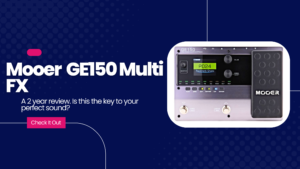Introduction
Are you looking to get the most out of your guitar tone? A multi-effects pedal allows you to craft exactly that, and have it in one convenient package. A multi-effects pedal (often referred to as a “multi-FX pedal”) can be an invaluable addition to your setup.

What is a Multi-Effects Pedal?
A multi-effects pedal is a digital effects processor that allows you to access a variety of guitar effects in one unit. It’s like having a whole pedalboard at your feet, without the hassle of multiple cable routing, power supplies, and space requirements.
What Makes a Multi-Effects Pedal Different from a Standard Effects Pedal?
The main difference between a multi-effects pedal and a standard effects pedal is that the former has as the name suggests multiple effects built-in. While a standard effects pedal may only have one or two effects, a multi-effects pedal may have dozens, if not hundreds of them. This makes it a much more versatile tool for guitar players looking to experiment with different sounds without buying a specific pedal you may only use once.
What Kinds of Effects Does a Multi-Effects Pedal Have?
A multi-effects pedal can have a wide range of effects, from classic analog effects like distortion and overdrive to more modern digital effects like delay and reverb. In addition, many multi-effects pedals also include modulation effects like chorus and phaser, as well as filters, pitch shifters, and even synthesizer effects.
Can I Tweak the Parameters of Each Effect?
Yes, most multi-effects pedals allow you to adjust each effect’s parameters, giving you fine-grained control over your guitar tone. The parameters you can change are often similar to those on a standard pedal, for example for an overdrive you’ll be able to change the; gain, volume, and tone.
Can I Chain Multiple Effects Together to Create Custom Guitar Tone "Patches"?
Absolutely! One of the biggest advantages of a multi-effects pedal is its ability to chain multiple effects together to create custom patches. This allows you to create your own unique guitar tone, tailored to your specific playing style. Depending on the particular model, some even allow you to choose which order you chain those effects. If you don’t know what difference that makes, check out the pedal board order page.
Can I Store These Patches and Recall Them in My Live Set-list?
Yes! Most multi-effects pedals have the ability to store your patches for quick recall during live performances. This can be a huge time saver, giving you more time to focus on your playing.
Do Any of These Pedals Also Feature Amp Modeling?
Yes, many multi-effects pedals include amp modeling as well. This means that you can simulate the sound of different amps and cabinets, allowing you to get a wider range of tones from your guitar. The big advantage of this is that you’re not restricted by the amp that you have, many will have presets of some of the most iconic amps in history.
What Are the Limitations of a Multi-Effects Unit?
While multi-effects pedals are incredibly versatile, they do have some limitations. For one, they can be a bit overwhelming at first, with so many different effects and parameters to adjust. I’ve often spent hours tweaking the settings trying to get the right sound. In addition, some guitar players prefer the simplicity and purity of individual pedals, which can offer a more focused and specific sound, particularly if they prefer analog circuits to digital recreations.
Conclusion
Multi-effects pedals can be really fun and let you get creative by putting together your own custom patches. With the ability to adjust and customize each effect, as well as chain multiple effects together, you can explore a wide range of sounds and styles. So why not try one out and see what kind of guitar tones you can create?
You May Also Like:
Make Music Magic with Top Effects Pedals for Beginners
As a beginner guitarist, the importance of utilizing guitar pedals...
Read MoreMooer GE150 Multi FX ultimate 2-Year In-Depth Review.
Is the Mooer GE150 Multi FX the key to your...
Read MoreTop 5 Tube Screamer Pedals. You Need To Try One!
A tube screamer is one of the most important pedals...
Read MoreWhat Is a Multi-Effects Pedal? you need to try one!
Introduction Are you looking to get the most out of...
Read More


